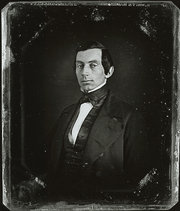Daguerreotype
|
|
The daguerreotype is a type of photograph, but, unlike modern photographs, it has no negative. Instead, it is an image exposed directly onto a mirror-polished surface of silver, (which has first been exposed to iodine vapour), housed in a velvet-lined folding case. While the daguerreotype was not the first photographic process to be developed, images of earlier processes tended to fade quickly when exposed to light. The daguerreotype photographic process was one of the first to permanently record and affix an image, and became the first commercially used photographic process.
The daguerreotype is named after its inventor, French artist and chemist Louis J.M. Daguerre, who announced its perfection (after years of experimentation) in 1839 (the French Academy of Sciences announced the process on January 9 of that year). Daguerre's patent was acquired by the French Government. On August 19, 1839 the French Government announced the invention a gift "Free to the World."
The daguerreotype was a positive-only process allowing no reproduction of the picture. The pre-exposure preparation of the plate resulted in the formation of photo-sensitive silver halide; and exposure to light formed a latent image. The development of the visible image was then effected by placing the exposed plate over a slightly heated (about 75°C) cup of mercury. The vapour of mercury condensed on those places where the light had acted in an almost exact ratio to the intensity of its action. This produced a picture in an amalgam, the vapour of which attached itself to the altered silver iodide. Proof that such was the case was subsequently afforded by the fact that the mercurial image could be removed by heat. The developing box was so constructed that it was possible to examine the picture through a yellow glass window whilst the image was being brought out. The next operation was to fix the picture by dipping it in a solution of hyposulphite of soda. The image produced by this method is so delicate that it will not bear the slightest handling, and has to be protected from being accidentally touched.
Daguerreotypy spread rapidly, except in England, where Daguerre had secretly patented his process before selling it to the French government.
Edgar_Allan_Poe_2.jpg
In the early 1840s the invention was quickly introduced (within a matter of months) to artists in the United States by Samuel Morse, inventor of the telegraph code. An exuberant market in portraits, often the work of itinerant artists who moved from town to town, sprang up. The first vintage erotica used daguerrotypes.
People often believe that the daguerreotype was the most commonly used method of photography into the late part of the 19th century. Actually this process was used for only about 10 years, before it was overtaken by other processes:
- the Ambrotype introduced in 1854, a positive image on glass, with a black backing
- the Tintype or Ferrotype, an image on chemically-treated tin
- the albumen print, a paper photograph produced from large glass negatives most commonly used in American Civil War photography.
The rapid move away from daguerreotype photography was inevitable; the process is intricate and complex, labor intensive, and involves many stages of production. This made daguerrotypes expensive and not affordable to the average person. Also, the typical exposure was often 60 to 90 seconds long, requiring the sitter(s) to remain immobile and hold a pose for all that time. Finally — and perhaps most important — since there is no negative, it had no intermediate stage from which a final image could later be reproduced.
Unlike film and paper photography, a daguerreotype can last virtually forever, when properly sealed.
Today these antique items are avidly collected. Some daguerreotypes - such as those by Southworth & Hawes of Boston, or George S. Cook of Charleston, South Carolina - are considered masterpieces of the art of photography.
Some parts of this text are derived from the 1911 Encyclopædia Britannica.
See also
References
Coe, Brian 'The Birth of Photography', Ash & Grant, 1976
External links
- An Index of 19th Century Daguerreotype Artists: Craig's Daguerreian Registry (http://www.daguerreotype.com/)
- The Daguerreian Society: History, database and galleries (http://www.daguerre.org/)
- Daguerreotype Portraits and Views, 1836-1864: US Library of Congress (http://memory.loc.gov/ammem/daghtml/daghome.html)
- The American Hand Book of the Daguerreotype (http://digital.library.upenn.edu/webbin/gutbook/lookup?num=167) from Project Gutenbergde:Daguerreotypie
es:Daguerrotipo he:דאגרוטייפ ja:ダゲレオタイプ nl:Daguerreotype pl:Dagerotyp ru:Дагеротипия

